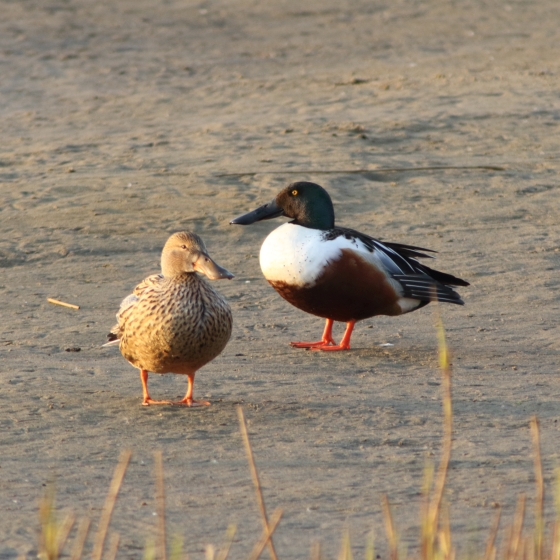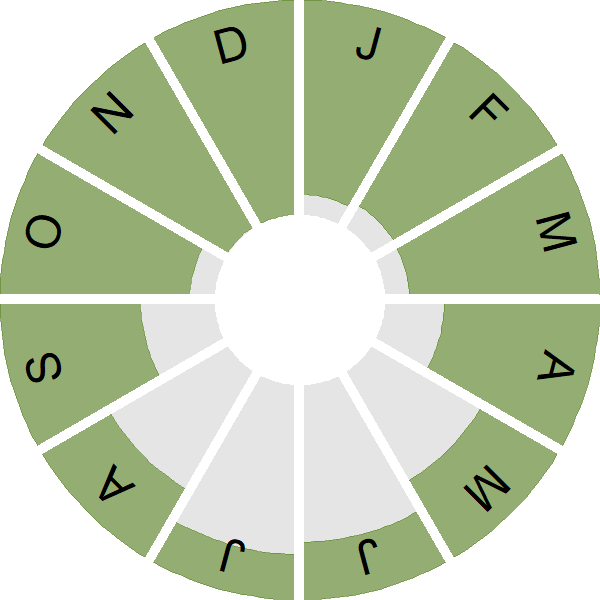Shoveler

Introduction
This familiar duck, with its large 'spade-like' bill, is a relatively scarce and localised breeder. Winter numbers are swelled by the arrival of wintering birds from further east.
The Shoveler is a rather specialized feeder, as its broad bill might suggest, feeding on zooplankton. One consequence of this is that Shoveler tend to favour more ephemeral waterbodies where potential competitors (e.g. fish) cannot survive.
Wintering individuals include birds from the breeding populations that extend from eastern Fennoscandia and the Baltic to western Russia, though many of these move further south into France and Spain, as do some individuals from our own breeding population.

Key Stats
Identification
ID Videos
This section features BTO training videos headlining this species, or featuring it as a potential confusion species.
Female dabbling ducks
Songs and Calls
Call:
Flight call:
Status and Trends
Conservation Status
Population Change
The Shoveler is predominantly a winter visitor to the UK but also has a widespread but localised breeding population with strongholds in East Anglia and Yorkshire and a five-year mean of 1,241 pairs during 2015–2019 (Eaton et al. 2021). There has been little change in the number of occupied 10-km squares since the 1968–72 Atlas, with losses offset by gains (Balmer et al. 2013). The recent trend is uncertain as it has only been an RBBP species since 2006 and, although numbers have increased during that period, it is unclear whether this increase is genuine or if it is due simply to increased observer effort and reporting (Eaton et al. 2021).
Distribution
Shovelers are present mainly in lowland areas, favouring a range of inland wetland sites and some coastal estuaries. They are most widely distributed and abundant in parts of southern Britain and in mid-western Ireland, as well as in parts of the Western and Northern Isles. Shovelers are relatively scarce and local breeders in Britain & Ireland, with breeding concentrated along low-lying floodplains and associated wetlands.
Occupied 10-km squares in UK
or view it on Bird Atlas Mapstore.
or view it on Bird Atlas Mapstore.
European Distribution Map
Distribution Change
Accompanying an increase in winter population size, Shoveler range size has increased by 36% since the 1981–84 Winter Atlas, and the majority of these gains have been in Britain, most notably in Orkney.
Change in occupied 10-km squares in the UK
or view it on Bird Atlas Mapstore.
or view it on Bird Atlas Mapstore.
Seasonality
Shovelers are most often seen in autumn and winter though can be seen in the breeding season at suitable breeding sites.
Weekly pattern of occurrence
The graph shows when the species is present in the UK, with taller bars indicating a higher likelihood of encountering the species in appropriate regions and habitats.

Movement
Britain & Ireland movement
Foreign locations of birds ringed or recovered in Britain & Ireland
Dots show the foreign destinations of birds ringed in Britain & Ireland, and the origins of birds ringed overseas that were subsequently recaptured, resighted or found dead in Britain & Ireland. Dot colours indicate the time of year that the species was present at the location.
- Winter (Nov-Feb)
- Spring (Mar-Apr)
- Summer (May-Jul)
- Autumn (Aug-Oct)

European movements
EuroBirdPortal uses birdwatcher's records, such as those logged in BirdTrack to map the flows of birds as they arrive and depart Europe. See maps for this species here.
The Eurasian-African Migration Atlas shows movements of individual birds ringed or recovered in Europe. See maps for this species here.
Biology
Productivity and Nesting
Nesting timing
Egg measurements
Clutch Size
Survival and Longevity
Survival is shown as the proportion of birds surviving from one year to the next and is derived from bird ringing data. It can also be used to estimate how long birds typically live.
View number ringed each year in the Online Ringing Report.
lifespan
Survival of adults
Survival of juveniles
Biometrics
Wing length and body weights are from live birds (source).
Ring Size
Classification, names and codes
Classification and Codes
- Order: Anseriformes
- Family: Anatidae
- Scientific name: Spatula clypeata
- Authority: Linnaeus, 1758
- BTO 2-letter code: SV
- BTO 5-letter code: SHOVE
- Euring code number: 1940
Alternate species names
- Catalan: ànec cullerot comú
- Czech: lžicák pestrý
- Danish: Skeand
- Dutch: Slobeend
- Estonian: luitsnokk-part
- Finnish: lapasorsa
- French: Canard souchet
- Gaelic: Lach-a’-ghuib-leathainn
- German: Löffelente
- Hungarian: kanalas réce
- Icelandic: Skeiðönd
- Irish: Spadalach
- Italian: Mestolone
- Latvian: platknabis
- Lithuanian: šaukštasnape antis
- Norwegian: Skjeand
- Polish: plaskonos (zwyczajny)
- Portuguese: pato-colhereiro
- Slovak: kacica lyžiciarka
- Slovenian: raca žlicarica
- Spanish: Cuchara común
- Swedish: skedand
- Welsh: Hwyaden Lydanbig
Research
Causes of Change and Solutions
Causes of change
The trend for the breeding population is uncertain and hence the drivers of change are also unclear.

